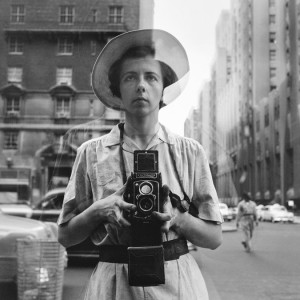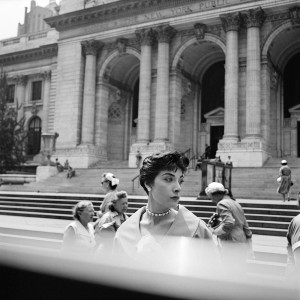 A few nights past Dr. Keepit and I watched ”Finding Vivian Maier,” a documentary about an unknown photographer whose street scenes, cityscapes and studies of ordinary people rival those of the great Robert Frank and Diane Arbus. Maier didn’t exhibit her photos during her lifetime; she spent most of her years toiling as a nanny for posh Chicago families, none of which ever saw her work. In fact, no one saw her work. She took thousands of photos, producing countless rolls of undeveloped film that she dumped haphazardly into shoeboxes. In 2009 she died a Dickensian death, penniless and alone, her genius a complete secret. Her treasures were left behind in storage containers she couldn’t pay for.
A few nights past Dr. Keepit and I watched ”Finding Vivian Maier,” a documentary about an unknown photographer whose street scenes, cityscapes and studies of ordinary people rival those of the great Robert Frank and Diane Arbus. Maier didn’t exhibit her photos during her lifetime; she spent most of her years toiling as a nanny for posh Chicago families, none of which ever saw her work. In fact, no one saw her work. She took thousands of photos, producing countless rolls of undeveloped film that she dumped haphazardly into shoeboxes. In 2009 she died a Dickensian death, penniless and alone, her genius a complete secret. Her treasures were left behind in storage containers she couldn’t pay for.
A box of Maier’s negatives was bought at auction by John Maloof, a Chicago real estate agent gathering material for a book he intended to write about the city. Astutely clocking that he had stumbled on a gold mine, Maloof set about buying up Maier’s possessions, including thousands of negatives, films, audio recordings, and tons of personal detritus packratted away over the preceding decades. From this teetering hoard, Maloof began to extract one of the most formidable photographic oeuvres of the twentieth century. Maier’s work was finally shown in proper gallery exhibits curated by Maloof, where it was fanatically received. Maloof eventually  produced the documentary to recount his odyssey in piecing together Maier’s enigmatic biography and bringing her photographs to light. He follows her footsteps from New York to Chicago, with stops back and forth to France, where her relatives lived, as well as an itinerant year abroad. Her tale is told by the children she looked after in the 1950’s, 60’s and 70’s, their parents, and Maier’s few friends. But the true stars of the film are Maier’s beautiful, somber, fascinating photographs.
produced the documentary to recount his odyssey in piecing together Maier’s enigmatic biography and bringing her photographs to light. He follows her footsteps from New York to Chicago, with stops back and forth to France, where her relatives lived, as well as an itinerant year abroad. Her tale is told by the children she looked after in the 1950’s, 60’s and 70’s, their parents, and Maier’s few friends. But the true stars of the film are Maier’s beautiful, somber, fascinating photographs.
As I watched I could fairly hear the pages of Dr. Keepit’s mental DSM-5 rapidly flipping as she c atalogued Maier’s possible diagnoses — PTSD, paranoid and narcissistic traits, depression, explosivity. (The Mrs. is a psychologist in addition to a runway model and gourmet chef.) As regards my own gray matter, two questions kept bubbling up to the surface: (1) who owns the copyright to all Viv’s biz? and (2) what kind of camera produced those wonderful, square, black and white images?
atalogued Maier’s possible diagnoses — PTSD, paranoid and narcissistic traits, depression, explosivity. (The Mrs. is a psychologist in addition to a runway model and gourmet chef.) As regards my own gray matter, two questions kept bubbling up to the surface: (1) who owns the copyright to all Viv’s biz? and (2) what kind of camera produced those wonderful, square, black and white images?
Only the second question was easy to answer. Per Todd Goodman, Los Angeles photography guru and principal of LA Light Photo: ”JB — From the date of the self-portraits you provided, that camera was either a Rollieflex 2.8B, C or D (likely the 2.8D) Twin Lens Reflex model. It used either a Schneider Xenotar 2,8/80mm or a Zeiss Planar 2,8/80mm taking lens and Compur Rapid MXV shutter. The aperture and shutter exposure settings on this model support the Exposure Value system (numbered 3 to 18 EV on top of the shutter speed dial knob). It has an arrow indicator that can be coupled or uncoupled to the aperture dial. The design of the shutter release lock guard is different and larger than previous models.” See how that works? You want a question answered you consult The Correct Authority. Whpssh!
 My copyright question, on the other hand, is a little trickier. KI2Y’s attractive and informed readers know that ownership of an item doesn’t mean ownership of the copyright in that item. Maloof also knew that but he did not consult The Correct Authority. In this case, the proper authority would have been a probate court. Instead, Maloof went off to find Maier’s closest living relative, to whom copyrights in her unpublished work would normally succeed. He hired a genealogist who located Maier’s cousin-once-removed, in France. After Maloof cut some kind of deal avec cet homme lÁ -bas, he believed he was entitled to start reproducing fine art prints from Maier’s negatives and selling them off for king dollars. And that’s when everything went to hell in a hand basket. (You knew that was coming, right?)
My copyright question, on the other hand, is a little trickier. KI2Y’s attractive and informed readers know that ownership of an item doesn’t mean ownership of the copyright in that item. Maloof also knew that but he did not consult The Correct Authority. In this case, the proper authority would have been a probate court. Instead, Maloof went off to find Maier’s closest living relative, to whom copyrights in her unpublished work would normally succeed. He hired a genealogist who located Maier’s cousin-once-removed, in France. After Maloof cut some kind of deal avec cet homme lÁ -bas, he believed he was entitled to start reproducing fine art prints from Maier’s negatives and selling them off for king dollars. And that’s when everything went to hell in a hand basket. (You knew that was coming, right?)
Enter David Deal, an opportunistic gonif fame-thirsty shark avid photographer and newly-minted lawyer from Virginia who claims to have found another, closer relative of Maier’s entitled to her pot o’ gold. (Legal lesson: for copyright purposes it doesn’t matter that Maloof’s French guy knew Maier and Deal’s French guy never heard of her. That’s where the term ”laughing heir” comes from.) Deal filed a claim notice in probate court in Chicago, throwing the question of ownership of Maier’s copyrights into the trustworthy hands of the Cook County judicial system.
So what’s gonna happen now, chief?
That depends. If the pair of Frenchman are equally distant from Maier they’ll share copyright ownership; if one is closer than the other he gets to eat the whole quiche himself.
Of course, it’s not that simple. The probate court can only determine and allocate the rights Maier had at the time of her death. But what rights, exactly, did she have when she died? Her belongings were auctioned off because she defaulted on her storage payments, meaning the contents of the storage containers — including her innumerable unpublished negatives — became the property of the facility owners. So did those owners acquire her copyrights? And could they have transferred those rights to Maloof?
All this already happened in California, by the way. Nearly identical issues arose in a case concerning a storage container stuffed with Jackson family memorabilia: velvet jumpsuits, platform shoes, sparkly gloves, Mama’s Pearls, etc. Also inside were unreleased master recordings. It went like so: In 1993 Jackson Communications Inc. decided to buy the Kramer Guitar company, whose instruments Tito and Jermaine pretended to play while actual  musicians performed off stage. When JCI inevitably defaulted on the purchase payments Kramer’s seller, New Jersey business guy Henry Vaccaro, filed suit and was awarded millions in damages. JCI filed for bankruptcy so Vaccaro started snagging tangible assets, grabbing a Rolls and grand piano off the Encino family compound repo-style. Vaccaro also bought the magic storage facility in the bankruptcy auction, which proved to be a giant IP Pandora’s box.
musicians performed off stage. When JCI inevitably defaulted on the purchase payments Kramer’s seller, New Jersey business guy Henry Vaccaro, filed suit and was awarded millions in damages. JCI filed for bankruptcy so Vaccaro started snagging tangible assets, grabbing a Rolls and grand piano off the Encino family compound repo-style. Vaccaro also bought the magic storage facility in the bankruptcy auction, which proved to be a giant IP Pandora’s box.
Members of Vaccaro’s crew (everyone in Jersey has a crew) set up MichaelJacksonSecretVault.com and other pay-for-access websites through which consumers could view rare photos and hear unreleased recordings of Gary, Indiana’s favorite sons from back in the day. Michael filed a suit alleging copyright infringement and misappropriation of name and likeness, among other claims, and was granted an injunction temporarily halting the operation. Jackson failed to prosecute the case and it was dismissed. But after he died in 2009, the Jersey boys created new websites and tried to resurrect the old racket. Jackson’s estate sued again, throwing in new claims for cyber piracy and unfair competition, and this time the estate prevailed. The Court decided that the creditors acquired only tangible personal items, but not intellectual property rights in those items. In other words, the homies could rock the fringed vest Marlon wore on The Flip Wilson Show, but couldn’t release albums of the unheard master tapes. (Not that a fringed vest wouldn’t be dope.)
You know, I could teach a whole law school course on just the Jacksons and their countless IP lawsuits — copyrights, trademarks, licensing, piracy, false endorsements, even post-mortem rights of publicity — it’s all there. (Note to self: ask Yale for a corner office AND an account at Sally’s.)
 We should expect a similar analysis with Vivian’s treasure trove. Her story is more complicated in that a huge market for Jacksons product already existed, and values of the stored merchandise could be reasonably estimated. But Maier never sold a thing in her lifetime. Not only was her huge body of work never exhibited, for the most part it was never even developed. Maloof was still establishing the market when Deal turned up and cast a shadow over his rights. The million dollar questions is: what was in the contracts between Maier and the storage facilities? Was there contractual language that would have forfeited Maier’s rights, including her intellectual property rights? Maybe; we’ll find out.
We should expect a similar analysis with Vivian’s treasure trove. Her story is more complicated in that a huge market for Jacksons product already existed, and values of the stored merchandise could be reasonably estimated. But Maier never sold a thing in her lifetime. Not only was her huge body of work never exhibited, for the most part it was never even developed. Maloof was still establishing the market when Deal turned up and cast a shadow over his rights. The million dollar questions is: what was in the contracts between Maier and the storage facilities? Was there contractual language that would have forfeited Maier’s rights, including her intellectual property rights? Maybe; we’ll find out.
As I write I’m wondering if any of Maier’s photos wound up in the public domain. Maloof already sold quite a few; whose copyright notice appeared on the prints? Was there any notice at all? (Every time one of my friends or clients posts a photo on the Internet without including a copyright notice it gives me a heart attack-ack-ack. They oughta know by now.)
My prediction: Maier’s work will eventually come out. Cash is king, and there’s too much money to be made from the the late nanny’s wonderful shots to let them languish in legal limbo. Dollars, Euros or both will change hands, and then we’ll get to see what was in all the shoeboxes.






Comments